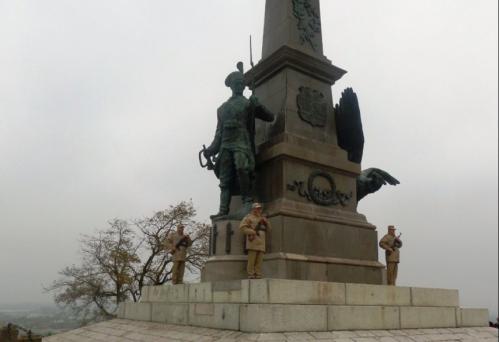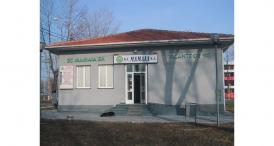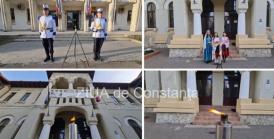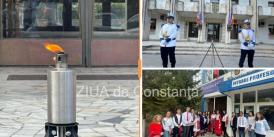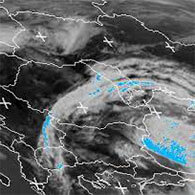#sărbătoreşteDobrogea Ambasadorul Marii Britanii în România, Paul Brummell - Britain in Constanta
#sărbătoreşteDobrogea: Ambasadorul Marii Britanii în România, Paul Brummell - Britain in Constanta
23 Nov, 2017 00:00
ZIUA de Constanta
 3520
Marime text
3520
Marime text
 3520
Marime text
3520
Marime text

 The story of how the United Kingdom played a central role in the building of the city of Constanta has its origins in the Irish Potato Famine of the 1840s and the growing realisation that the British Isles were no longer self-sufficient in food. Across Western Europe other governments were grappling with similar challenges of feeding their populations. The repeal of the Corn Laws provided an impetus to a British policy of support and encouragement for free trade, which has been a defining characteristic of the United Kingdom to this day.
The story of how the United Kingdom played a central role in the building of the city of Constanta has its origins in the Irish Potato Famine of the 1840s and the growing realisation that the British Isles were no longer self-sufficient in food. Across Western Europe other governments were grappling with similar challenges of feeding their populations. The repeal of the Corn Laws provided an impetus to a British policy of support and encouragement for free trade, which has been a defining characteristic of the United Kingdom to this day.In their search for sources of grain to meet the burgeoning demands in Western Europe, British merchants looked with great interest at the fertile lands of Wallachia and Moldavia. But in the late 1840s and early 1850s there was a problem. The export route for the grain was the Danube River, but its mouth was a delta with multiple channels, under the control of Russia. The latter had no interest in seeing grain exports along the Danube becoming rivals to its own exports from Odessa, and thus Russia did much to hinder the trade, for example through burdensome quarantine restrictions and paying only lip-service to its commitments to dredge the channels.
This Russian obstructionism in developing the Danube grain trade was indeed one of the factors which encouraged the United Kingdom to join with Turkey in the Crimean War against Russia.
Russia’s defeat in that conflict was to provide a powerful impetus to British investment in developing the Danubian grain trade, both in the provisions of the Treaty of Paris regarding free navigation of the Danube and in providing a more stable footing for the Ottoman Empire, which was thus better able to conduct business affairs. In his 1857 memoir “The Danube and the Black Sea”, Thomas Forester wrote: “By a law of compensation in the wise order of Providence, the hurricane of war, like the tempest and the thunderstorm, clears the atmosphere; and, while sweeping the earth with desolation, prepares it for fresh processes of culture and improvement. The clouds dispersed, halcyon days succeed, which, turned to profit, afford new scope for industrial pursuits” (p. 2).
The Treaty of Paris established a European Commission for the Danube, whose task it was to improve the navigability of that river, to promote trade. But the challenges around the shallow and meandering channels of the Danube Delta looked daunting, and British investors searched for other routes through which the grain trade might more easily be developed.
They focused in particular on the geographical quirks of the course of the Danube River which, after flowing eastwards for hundreds of miles, marking the current border between Romania and Bulgaria, turns sharply north, just east of the town of Calarasi. In doing so, it is brought, at Cernavoda, to a point just 40 miles from the Black Sea, at the present day port of Constanta. If grain could be conveyed from Cernavoda to Constanta, the tribulations of navigation through the Danube Delta could be avoided.
The French had constructed a cart track along this route during the Crimean War, to supply food and fodder for their armies in Crimea. A British entrepreneur named Thomas Wilson proposed the construction of a canal, and secured the approval of the Ottoman administration through a decree, or firman, to work up the project. He brought in the services of a British engineering company, Liddell and Gordon, who were to prove highly significant in the development of Constanta. Charles Liddell was a distinguished civil engineer, who helped develop the Midland railway in England, and whose niece was the model for Alice in Lewis Carroll’s “Alice in Wonderland”.
Lewis Dunbar Brodie Gordon was to become the UK’s first ever professor of engineering, at Glasgow. Liddell and Gordon’s report on the feasibility of Wilson’s canal project was however discouraging, and investors focused instead on an alternative and apparently more straightforward project: the construction of a railway, coupled with the development of Constanta as a free port.
Thomas Forester’s memoir “The Danube and the Black Sea” is in essence a promotional pamphlet for this project. Forester describes the town of Kustendjie, as Constanta was then called, as a degraded one, having suffered Russian predations, and which according to him “now contains a population of only 40 inhabitants.” (p32) But Forester sees huge potential in the place, writing that “there can scarcely be imagined a more favourable site for a commercial city.” (p62)
Forester sets out the objectives underpinning the proposal in strongly commercial terms, writing: “It proposes to link the East and the West of Europe by the bonds of a commercial intercourse mutually beneficial, providing a new channel for the corn trade of territories teeming with cereal wealth - a matter of the last importance to the governments and populations of Western Europe - while it opens markets in the corn-producing countries for the manufactures and colonial luxuries demanded by a growing civilization” (p. 78-79).
Forester’s enthusiasm for the project is seen in his glowing descriptions of the resources, wealth and climate of Wallachia, writing:
“From April to December they have seven months of a genuine Grecian summer - cloudless skies, balmy breezes and out-of-door life” (p. 86).
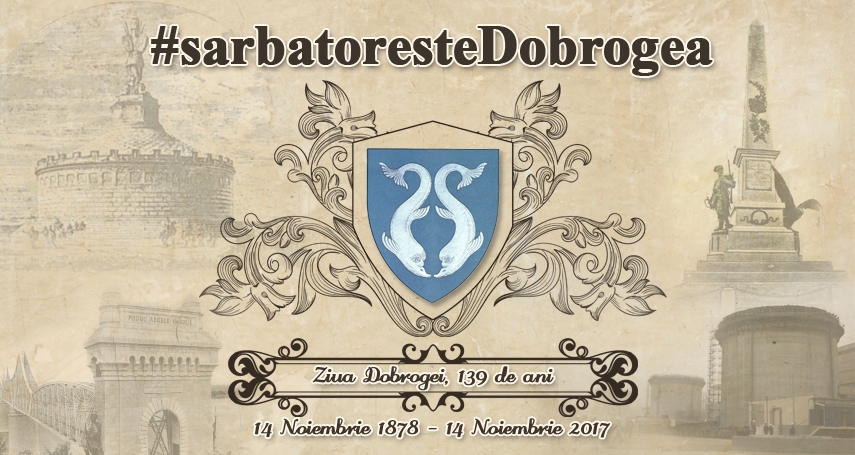 Probably the only time that the climate of Romania in December has been likened to that of a Grecian summer. And he is at pains to contradict what he identifies as a prevailing view in the West of Dobrudja as an unhealthy region.
Probably the only time that the climate of Romania in December has been likened to that of a Grecian summer. And he is at pains to contradict what he identifies as a prevailing view in the West of Dobrudja as an unhealthy region.Forester’s pamphlet is firmly underpinned by the unshakable confidence in the advantages of free trade, writing: “Upon the sound principles now firmly established in the country, it is no part of the government or the legislature to interfere with the relations of commerce, except in the way of removing its burthens and restrictions and granting facilities for its expansion” (p. 137).
For Forester, free trade in corn was the best safeguard against famine. And if the Danube to Black Sea Railway was built, and the port of Constanta developed, he predicted that:
“The Danubian Provinces, alone, are capable of exporting, on the average of years, a very large proportion, perhaps one half, of the six or seven million quarters of grain required to meet the general deficit of European production” (p. 136).
But in true Victorian style Forester also dwells on a view that this commercial project will bring in its wake considerable philanthropic benefits. While lamenting what he indentifies as a “degraded character” of the local peasantry, Forester is convinced that:
“He may be raised from his apathy by better prospects, and stimulated to industry by security for his gains and the comfort and independence they procure” (p. 94).
He argues that his scheme therefore “claims the sympathy of the philanthropist for the moral and social benefits which must naturally follow in its train” (p. 79).
Forester is convinced that the construction of the railway and the development of the Port of Constanta will generate British settlement in the region: “At least a sprinkling of neat English homesteads would take the place of the mud huts and rush hovels of the Wallachian and Bulgarian peasants, and form models for their imitation” (p. 161).
And not just the English. Forester believes that large numbers of German migrants would follow and that “the tide of population, after flowing westwards for 400 years, [would] be turned back to the East” (p. 167). Forester argues that this immigration would be beneficial for the project, though it would not be essential to its success. And he cites a wide range of other potential advantages for the scheme, including the strategic advantage for Turkey in the development and fortification of the port of Kustendjie. He envisages the scheme helping to revive the ancient trade of the Euxine, providing “a means for conveying the commodities of the East to Europe” (p. 192).
He laments that: “For four centuries the commerce of the Black Sea has been nearly stagnant under Turkish rule, and since the Russian czars extended their frontier to its northern coasts it has been further circumscribed by their jealous restrictions” (p. 197). And he believes the scheme will develop tourism to the region, in which: “The English colony of Kustendjie may naturally become a pleasant resting-place, where the traveller will halt to refresh himself after his fatigues, and prepare for further enterprises” (p. 209).
The Ottoman government accordingly agreed a concession contract with the Danube and Black Sea Railway and Kustendjie Harbour Limited, which was given the land needed for the project for a term of 99 years, but on condition that the railway was ready for use in three years. Invested capital of some £400,000 was put up by 64 British shareholders. Many of these were linked to the Midland Railway company, such that the line between Cernavoda and Constanta came to be regarded in some quarters as a distant overseas cousin of the Midland. Prominent investors included Sir George Ernest Paget, Chairman of the Midland Railway; Herbert Ingram, founder of the Illustrated London News; and shipping magnate Sir Samuel Cunard.
The concession contract was signed on behalf of the company by John Trevor Barkley, who also served as project manager. With the company working to such a tight deadline, they did not have time to appoint a contractor. The consultancy was the work of engineering company Liddell and Gordon. Among the by-products of the new railway was the building up of Medgidia, on the line, as a new town, named after the then Ottoman Sultan, to serve as an economic hub for central Dobrudja and to house refugees from the Crimean War.
Work on the railway began in 1857, with Barkley joined by his younger brothers, Henry, George and Robert, and by his brother-in-law, Douglas Austhwaithe Stanley. Henry Barkley wrote an account of his experiences, “Between the Danube and Black Sea or Five Years in Bulgaria”, published by John Murray in 1876. But he is better known today for his 1896 book, “Studies in the Art of Rat-Catching”, ostensibly intended as a practical guide for English public school boys, and based on the fictional recollections of master rat-catcher Bill Joy. It was reworked by the US actor, director and writer, Crispin Glover as “Rat Catching” in 1988.
The railway was dully finished in 1860. But the Danube and Black Sea Railway faced unexpected difficulties arising from the impressive work of another British engineer. This was Sir Charles Hartley, chief engineer for the European Commission for the Danube, whose engineering feats in eliminating the obstacle to navigation provided by the Sulina Bar facilitated trade from Galati and Braila to the Black Sea via the Danube Delta, earning Hartley the popular title of “Father of the Danube”. This gave the railway unwelcome competition.
Nonetheless, the new Danube and Black Sea Railway and the modern port of Constanta performed efficiently. Locomotives for the railway were produced at the Bayer and Peacock works in Gorton, Manchester. One of them, locomotive 683, named Thighina by the Romanians, built in 1861, was still in use in 1944, when it was destroyed by US bombing in Bucharest. In 1864 a private Danube and Black Sea Railway Company post was established with its own stamps, providing the postal link between Constanta and Cernavoda, and between maritime and Danube River shipping companies.
But the strategic and commercial importance of cereals from the Danube Principalities was declining. Wheat from the area was no longer considered a strategic resource since Western European demand was being met by rapidly growing supplies from the expanding North American frontier. Tellingly, Britain and other Western European powers did not involve themselves in the Russian-Turkish war of 1877-78. A distinguished role was nonetheless played by Edward Harris, General Director of the Danube and Black Sea Railway Company from 1868 to 1882, in helping to avert the destruction of Constanta during the war. And indeed the operation of the railway continued throughout the war, with those Russian troops using the trains reportedly even paying for their tickets.
In a sign of the importance played by the Danube and Black Sea Railway in the development of Constanta, Carol I, in his first official visit to Dobrudja in 1878 following its unification with the Romanian State, insisted on being the guest of Edward Harris while in the city.
Harris’s last key role was as part of the team negotiating the sale of the Danube and Black Sea Railway to the Romanian State in 1882. The company’s final dividend was paid in 1884. Among its joint liquidators were Charles Liddell and George Barkley.
The UK then played a central role in the development and modernisation of the city and port of Constanta. My own visits to Constanta over the past three years have taken in a bilateral business event jointly hosted with the Constanta Chamber of Commerce and Industry, a regional ports event, showcasing the strengths of British companies in supporting the modernisation of port facilities across Central Europe, and the visits of British T-45 destroyers, among the Royal Navy’s most modern warships, part of the strengthening of our bilateral defence ties. All of these are signals of Britain’s continuing engagement with Constanta, a city in whose role in helping to build the UK is proud.
Cotidianul ZIUA de Constanţa publică, în această perioadă, mesaje dedicate Zilei Dobrogei, în cadrul proiectului #SărbătoreşteDobrogea, dedicat împlinirii a 139 de ani de la revenirea provinciei la România şi a 17 ani de activitate jurnalistică. Fie că Dobrogea este locul lor natal sau nu, personalităţi din diferite domenii şi reprezentanţi ai instituţiilor de pe plan local şi naţional ni s-au alăturat în acest proiect aniversar, transmiţând pentru cititorii noştri mesaje dedicate celebrării provinciei istorice dintre Dunăre şi mare. Rămâneţi alături de noi pentru a marca această sărbătoare!
Citeşte şi:
ZIUA de Constanţa lansează, în curând, Îndreptarul de iubire
Zi după zi, până la Ziua Dobrogei, ZIUA de Constanţa va fi semnalul, apelul, conştiinţa care #sărbătoreşte Dobrogea
Ziua Dobrogei, 139 de ani. 14 noiembrie 1878 - 14 noiembrie 2017
Ziua Dobrogei
#sărbătoreşteDobrogea: ZIUA de Constanţa invită autorităţile la o masă rotundă
#sărbătoreşteDobrogea: Mesajul prof. univ. dr. ing. Garabet Kümbetlian, membru titular al Academiei de Ştiinţe Tehnice din România
#sărbătoreşteDobrogea: Mesajul lui Gheorghe Hristodol - Institutul de Istorie „George Bariţiu“ al Academiei Române, Cluj-Napoca
#scrieDobrogea: Dobrogea în inima şi conştiinţa mea
#citeşteDobrogea: 1878. Decizia Consiliului Comunal Brăila privind alocarea bugetului festivităţilor trecerii armatei române în Dobrogea
Urmareste-ne pe Grupul de Whatsapp
Comentarii
 Fondul Documentar Dobrogea de ieri și de azi
Fondul Documentar Dobrogea de ieri și de azi




_thumb2.jpg)
